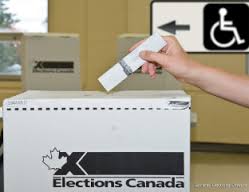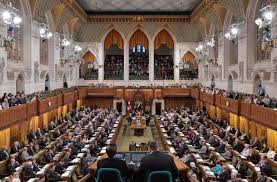Burlington’s Member of Parliament, Karina Gould, will be leading a public consultation on Electoral Reform at the Mainway Recreation centre in the auditorium on Saturday September 10th at 12:30.
She wants to hear what her community has to say about the changes Justin Trudeau promised to deliver in the way of electoral reform. During the election campaign Trudeau said that election was the last that would be run under the First Past the Post (FPTP) process Canada has been using since Confederation.
 By Jay Fallis
By Jay Fallis
August 31, 2016
BURLINGTON, ON
Part 2 of a 3 part series on electoral reform.
Yesterday, I described the system Canada has been using since Confederation to elect its members to the House of Commons – First Past the Post – FPTP
The Liberal party promised to change this approach during the last federal election. The MP’s are now meeting with their constituents to discuss what the approach should be if not FPTP
A possible approach is referred to as Mixed Member Proportional system, or MMP.

Will a more representative method of electing Members of Parliament result in a higher voter turn out?
In this system each voter receives two ballots. One is used to select the local candidate of their choice, while the other is used to select the party of their choice. The ballots selecting the local candidate are tallied up in each riding, and the candidate with the most votes wins. This is the same in our current system, except for the fact that the ridings would be bigger.
Once the local seats are decided, the ballots which indicate party preference are tallied and the popular support of each party is determined by adding up to a total percentage out of 100. In order to ensure that each party has a number of seats reflective of the popular support they received, there are a designated number of seats distributed in accordance with the percentage of each party. In our Parliament it would probably be about 100 seats.
To give you an idea, let us pretend that instead of 338 seats in the House of Commons, there were 200. Of those, 100 would be designated for ridings and the remaining 100 would be designated to ensure that the popular vote is reflected in the Legislature. Let us say that the Liberals won every single riding, yet only amassed 50% of the popular support. Additionally, the NDP and Conservatives were unable to win a single riding seat, but each amassed 25% of the popular support. This would mean that the remaining 100 seats would be divided evenly between the NDP and Conservatives. Thus, the legislature would be reflective of the popular vote because the liberals would have 50% of the seats, leaving the other two parties with 25% each. Regularly there are more seats and parties to make it so that the equation is more intricate, but in essence the way that the seats are distributed is the same.
This explanation begs the question; who will be selected to sit as members in these non-riding seats? One way is to allow voters to choose their favourite representatives of the party for which they voted. The candidates from each party that receive the highest approval ratings would then be selected to fill these seats.

Is it just a matter of putting bums in seats or do we want to find a more representative method of electing Members of Parliament?
This concept of “list” seats is probably one of the most controversial aspects of this system. Some support it as voters can elect qualified candidates who would otherwise fail in local ridings. Furthermore, voters of all political stripes throughout the country will most likely have a member that will represent their political interests. On the other hand, critics argue that extended ridings and lack of local affiliation will make it so that MPs will not be as accountable to the electorate.
There is also the issue of conflicting jurisdiction for each elected official. Initially in the Scottish Parliament, the MMP system led to disputes over which Member of Parliament had jurisdiction to handle particular issues thus creating two classes of MP. However, many of these problems could be resolved either through a change in political culture or through modified legislation.
Although MMP is not perfect, it’s most profound advantage is that it ensures that all voters who support different party stripes are adequately represented in the legislature. In this system, almost all votes cast are taken into consideration leaving all parties accurately represented.
As it stands, it seems difficult to perceive that MMP would be introduced without a hitch. It is not the system endorsed by our current Prime Minister, and there is much opposition over certain aspects, especially the presence of the list selection process.
Nevertheless, implementing MMP would certainly produce a Parliament that better represents Canadian voters and be a marked improvement on our current system.
First of a three part series on election reform.
 Jay Fallis is a graduate of the University of Toronto where he earned a Master’s Degree that focused on electoral reform. He writes a column for a daily newspaper in Ontario, the Orillia Packet and Times,
Jay Fallis is a graduate of the University of Toronto where he earned a Master’s Degree that focused on electoral reform. He writes a column for a daily newspaper in Ontario, the Orillia Packet and Times,
















Hi Everyone,
Thanks so much everbody for reading! I absolutely encourage everyone to heed Kurt’s advice and check out Fairvote Canada’s website (fairvote.ca) there is more to learn!
To the Lonely Taxpayer- I would have to disagree with your first point. Not all reforms allow small, special interest, parties to emerge. Only those that use lists, and even still, there are a variety of safeguards that can be put in place to avoid the emergence of such parties (higher entry quota for parties and different proportional equation (i.e. D’hondt method over Sainte-Laguë method). Using the New Zealand MMP model and last elections results (although they would be subject to some change) the only small party to receive more seats would have been the Greens. Furthermore, it is often suggested that the emergence of these parties is in part due to the political culture of a country not just the electoral system.
As for your Beer+BlueJays party- count me in for a vote as well!
Thanks again,
Jay
Two things…
1. Electoral reform means interesting fringe parties (Marijuana Party, Communist Party) get elected, and eventually new parties get created. Israel has about +50 political parties (Judean People’s Front & People’s Front of Judea), while Italy has +100, yet neither Israel or Italy are as “multicultural” as Canada is.
2. Unlike our American neighbours to the south, Canadians enjoy a short six to eight week election process. Once all these new parties are represented in Parliament, the election process will go on for years.
For those two reasons (plus my being unwashed) I voted status quo at the last referendum. But create the “Beer+BlueJays” party and it’s got MY October vote.
@Kurt
“This is the same system of electoral reform proposed for Ontario some time back, it went to a referendum and failed as most people did not bother to learn about it and stuck with the status quo.”
Please accept my apology for being ignorant and one of the “unwashed” as your statement would seem to infer,but while not being as astute or informed as you perceive yourself to be, the fact that the referendum question was defeated was by “Democratic” first principles.
The fundamental that the government ignored here is, “If you aren’t going to like the answer do not ask the question.”
While you seem to have an abundant faith in the current federal government to make this decision where they won the majority of seats 188/338 with only 39.4% of the popular vote perhaps you wouldn’t object to the current government disposing of some of your rights and freedoms also.
If this parliament were to proceed without a Referendum/plebiscite on this question alone it would be the absolute antithesis of the democracy you currently disfavour.
As for me I will pass.
Selecting members for non-riding seats is a serious weakness in the system described above. Every seat should represent a riding without exception; we have enough unelected members of government already (in the senate) and keeping the system as simple as possible should be a very high priority.
A better system would be a ranked ballot – one in which, if my first choice fails to win, my second choice is activated and the candidate with the fewest votes is eliminated – all with one ballot.
Good start to explain MMP. I suggest folks also look at the Fair Vote Canada explanation at https://www.fairvote.ca/proportional-representation/. It has a few differences from Jay’s explanation.
This is the same system of electoral reform proposed for Ontario some time back, it went to a referendum and failed as most people did not bother to learn about it and stuck with the status quo. I prefer the route taken by the current government, have parliament decide after extensive public consultation.